
Last June, during the International Polar Year conference, James Overland suggested that there are more cold and snowy winters to come. He argued that the exceptionally cold snowy 2009-2010 winter in Europe had a connection with the loss of sea-ice in the Arctic. The cold winters were associated with a persistent ‘blocking event’, bringing in cold air over Europe from the north and the east.
Last year’s cold winter over northern Europe was also associated with an extreme situation associated with the North Atlantic Oscillation (NAO), with the second lowest value for the NAO-index on record (see figure below).
I admit, last winter felt quite cold, but still it wasn’t so cold when put into longer historical perspective. This is because I remember the most recent winters more vividly than those of my childhood – which would be considered to be really frosty by today’s standards. But such recollections can be very subjective, and more objective measurements show that the winters in Europe have in general become warmer in the long run, as explained in the German blog called ‘Wissenlogs’. If there were no trend, then such a low NAO-index as last year’s would normally be associated with even colder conditions over Europe than those observed during the previous winter.
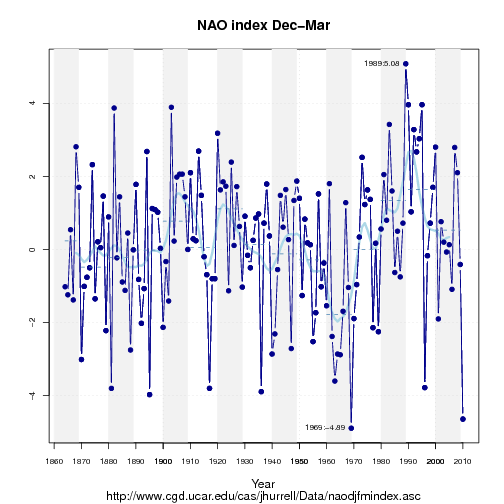
In a more recent press-release, Vladimir Petoukhov and Vladimir Semenov, argue that Global Warming could cool down winter temperatures over Europe, and a reduced sea-ice extent could increase the chance of getting cold winters. Also they propose that cold winters are associated with the atmospheric circulation (see schematic below), and their press-release was based on a paper in Journal of Geophysical Research (JGR), which may seem to have a serendipitous timing with the cold spell over Europe during the last weeks. However, the original manuscript was submitted in november 2009 (before the statement made by James Overland) and accepted in May 2010. One could regard the paper more as a ‘prediction’ rather than an ‘explanation’.
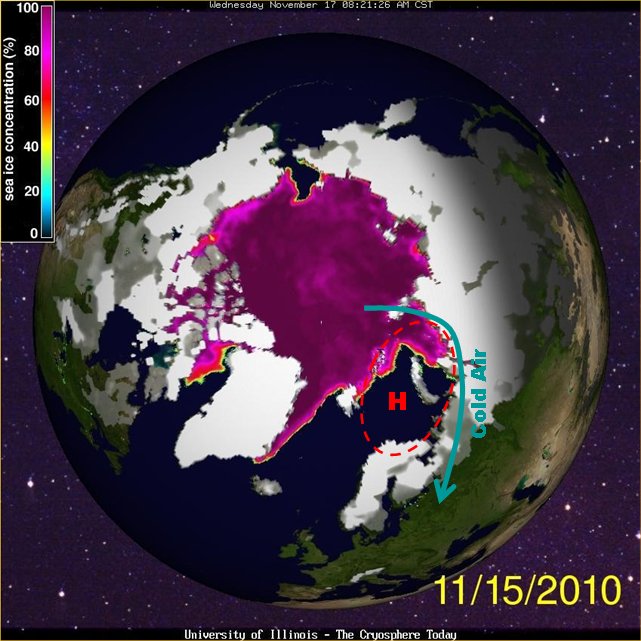
Although Petoukhov and Semenov’s findings sound plausible, I don’t think they are as straight-forward as they initially seem in terms of their implications for this winter either. For one thing, it is impossible to prove that one single event is due to a change in the long-term, as we pointed out for the case of hurricanes (The 2010 hurricane season this year, by the way, was quite active).
I think it is important to keep in mind that the Petoukhov and Semenov study is based on a global atmosphere model that simulated a non-linear response to the loss of sea-ice in the Barents-Kara seas: initially warm winters, followed by cold, and then warm winters, as the sea-ice extent is gradually reduced.
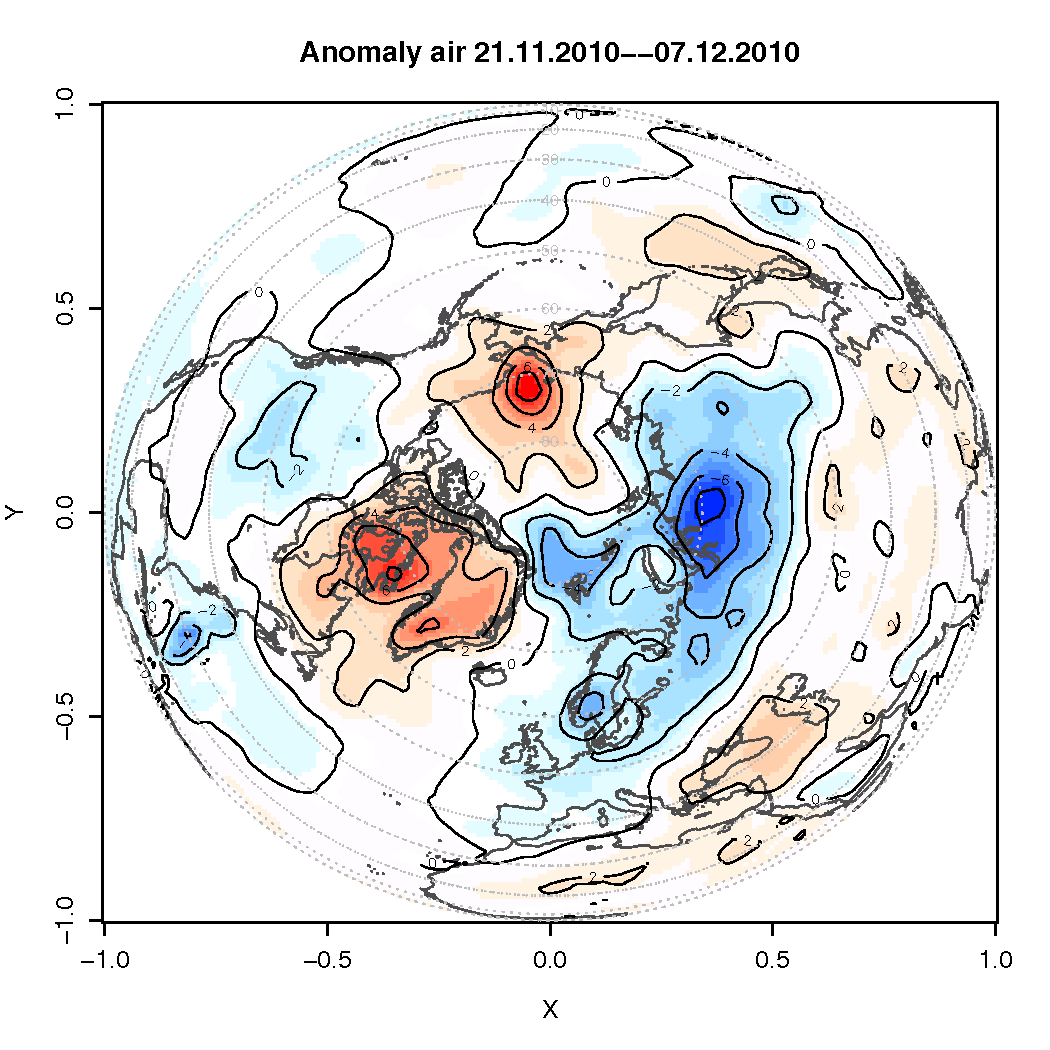
One interesting question is how the Barents-Kara sea-ice affects the winter temperatures over the northern continents. By removing the sea-ice, the atmosphere above feels a stronger heating from the ocean, resulting in anomalous warm conditions over the Barent-Kara seas. The local warming gives rise to altered temperature profiles (temperature gradients) along the vertical and horizontal dimensions.
Changes in the temperature profiles, in turn, affect the circulation, triggering a development of a local blocking structure when the sea-ice extent is reduced from 80% to 40%. But Petoukhov and Semenov also found that it brings a different response when the sea-ice is reduced from 100% to 80% or from 40% to1%, and hence a non-linear response. The most intriguing side to this study was the changing character of the atmospheric response to the sea-ice reduction: from a local cyclonic to anti-cyclonic, and back to cyclonic pattern again. These cyclonic and anti-cyclonic patterns bear some resemblance to the positive and negative NAO phases.
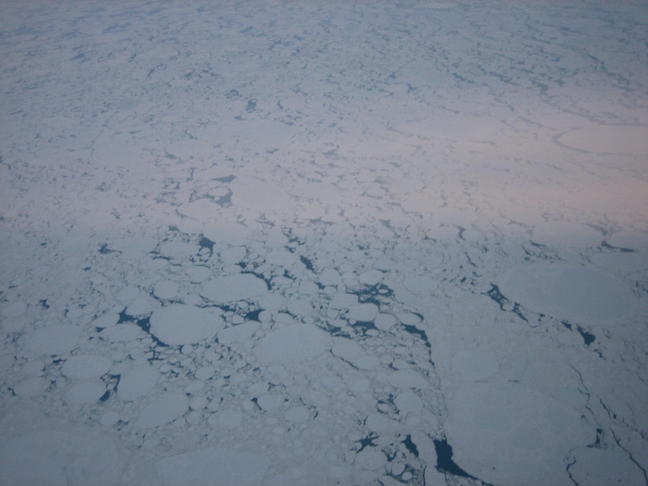
They also show a different response in surface air temperature (SAT) during December, January, and February. From their Figure 2, it is not immediately obvious from that figure that a sea-ice reduction leads to lower SAT during January. This is, however, very much in line with similar analysis that I have carried out with colleagues and struggled to find a consistent response (albeit we looked at the summer season).
But Petoukhov and Semenov provide theoretical support for their observations, and argue that the non-linear response can be explained in terms of ‘convectional-frictional’ and ‘baro-clinic-frictional’ mechanisms. The former includes warming over the areas where sea-ice disappear, and changes in the vertical temperature gradients, stability, and hence friction, while the latter involves a change in the surface friction force associated with temperature changes over distances.
I think that the scientific community will need some time to confirm this link, and there are some
important caveats: For one thing, the spatial model resolution (the size between the boxes in the grid mesh, through which the models represent the world) has an influence on their ability to represent blocking frequency. Hazeleger et al. Has observed that “… different horizontal resolutions … confirm the resolution-dependence found in NWP [Numerical Weather Prediction]”. The atmospheric model used by Petoukhov and Semenov has a fairly coarse spatial resolution (2.8 degrees x2.8 degrees), and it is legitimate to question whether it can reproduce the
frequencies of blocking events realistically, and whether that has a bearing for the conclusions.
But also the fact that the sea-surface temperatures (SSTs) were fixed in these experiments may affect the conclusions. Balmaseda et al. found that the atmospheric response to changes in sea-ice conditions may depend on the background SSTs, at least for the summer months. They also compared results from a coupled ocean-atmosphere model with the results from an atmosphere model for which the SSTs were given. Their unexpected finding was that the atmospheric response in these two cases were very different.
In fact, global atmospheric and climate models are better at describing the large picture than more regional and local characteristics. There is a limit to what they are able to describe in terms of local regional details, and it it reasonable to ask whether the response to changes in regional sea-ice cover is beyond the limitation of the global model. If different models give different answers, then it is likely that the response is not robust.
Another interesting question is whether the sea-ice the is whole story. Not long ago, there were some suggestions of a link between low solar activity and cold winters (this correlation, however, is so weak that you would never notice without statistical analysis. Also see comment here). Do these factors affect the circulation patterns over the North Atlantic? The sunspots tend to vary on a time scale of 10-12 years, but the NAO-index suggests that few of the extreme low values were repeated over two subsequent years. In other words, the NAO doesn’t show the same persistence as the sunspots. It will be interesting to see if this winter will break with previous patterns – if it does, that could be interpreted as a support of Petoukhov and Semenov hypothesis.
It is nevertheless no contradiction between a global warming and cold winters in regions like Europe. Rather, recent analysis suggest that the global mean temperature is marching towards higher values (see figure below), and Petoukhov and Semenov argue that the cold winter should be an expected consequence of a global warming.
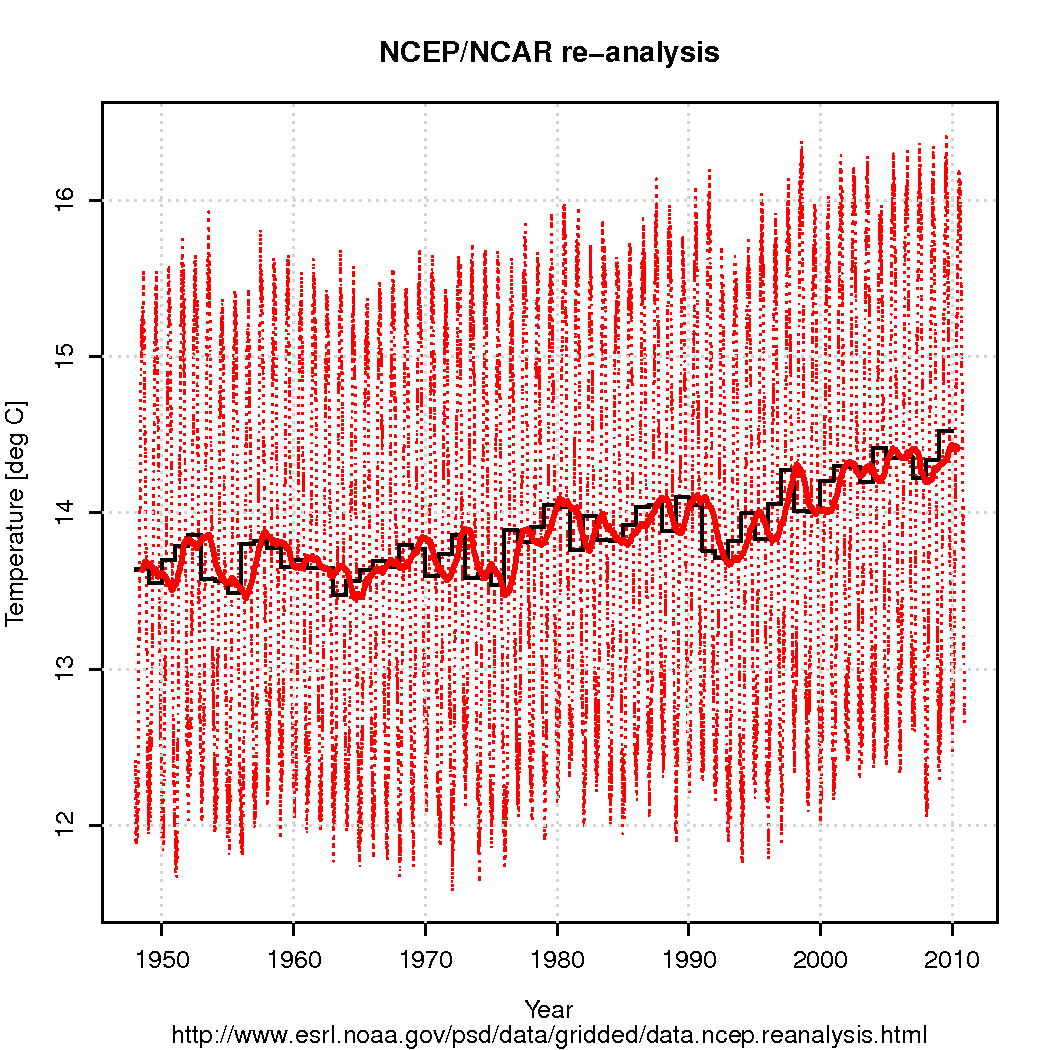
Re 77 Edward Greisch Alfven waves require ionized gas [plasma] and happen on the sun.
(And Earth’s magnetic field?) Does it have to be a plasma? I’ve wondered if they could exist in the outer core? (Rossby waves could, I think (refering to IPV, that requires a continuously-stratified fluid; in a layer that is not stratified (such as the outer core), a PV can be defined that is inversely proportional to the layer thickness (in terms of mass if the fluid is compressible) and Rossby waves would propagate if there is a gradient in such PV (ignore local horizontal and vertical; consider the whole outer core in cartesian coordinates aligned with Earth’s axis; the spherical geometry creates variations in layer thickness with distance from the axis); I also think that the propagation of barotropic topographic Rossby waves can be seen as related to the stability of Taylor columns (Taylor columns are expected to exist in the outer core, at least outside the tangent cylinder that wraps around the inner core – potential consequences for change in geodynamo between when the whole core was molten and when the inner core started growing – PS latent heat release and rejection of less dense liquid (analogous to salt rejection when water freezes) occur as the inner core grows while sensible heat must flow out as the temperature decreases; I wonder to what extent the outer core is like and not like the atmospheres of gas giants…) (PS it would be interesting to describe the fluid dynamics of the atmoshpere, ocean, outer core, sun, gas giants, and mantle in parallel, noting similarities and differences (ie force balance in mantle is dominated by pressure – viscosity; atmosphere synoptic scale outside of low latitudes: pressure – coriolis; etc.)
Yes I knew they don’t happen in the atmosphere (aside from the magnetosphere, not sure about E-region dynamo) or ocean (or crust or mantle); I just through them in there because at that point I was refering to fluid-mechanical waves in general.
“88
dhogaza says:
19 December 2010 at 1:17 PM
Steckis:
The last two weeks have been the coldest in England since the second-to-last solar minimum, many hundreds of years ago.
Also the December temperatures in Berlin are the coldest for 100 years.
So dude, the Russian weather eventn is no more unusual than the current cold weather events.
The Russians claimed that the heat wave in Moscow is unprecedented, which is somewhat more unusual than “coldest for 100 years” or even “many hundreds of years”.
Some estimates have it as being possibly a one-in-three-thousand year event.
Unprecedented. You can look up that word in the dictionary …”
It depends on which Russians you are talking to and how you define unprecedented. They would not have a clue if similar events occurred six or seven or eight hundred years ago. So, such an event being unprecedented is BS.
99
Ray Ladbury says:
19 December 2010 at 8:44 PM
“Steckis, Neither the Russian heat wave nor the current European cold constitutes evidence for or against anthropogenic climate change. It is interesting weather, that is all.”
Isn’t that what I said Ray? Where did I use the term anthropogenic anything in my post?
By the way, if you are implying that I am the hibernating denialist then I guess you would be too if you contracted cancer.
Stekis seems to be doing a little selective copy-paste of 2nd hand speculation . . . . without understanding what exactly an “ice age” is, or when the “2nd-to-last” solar minimum was, although that does seem to coincide with what I’ve heard was about the last time the Brits got an early Dec this cold -> 1962
Ray:
You might want to investigate further.
Really, as a rule of thumb, is Steckis agrees with you, you’re probably wrong … consider his track record :)
Really, the Russian heat wave was scary statistically in ways that thus far the cold (but not all that cold) couple of weeks in Europe has not been.
Why not? Show your work, and explain why the professional Russian met people are wrong, why you, with a BS in fish stuff, not the physical sciences, and with no advanced degree, are right.
> They would not have a clue if similar events
> occurred six or seven or eight hundred years ago.
You think they don’t have access to their own history?
You do. Why not look it up?
http://scholar.google.com/scholar?q=russian+history+1200AD
On the climates of history
RA Bryson… – Journal of Interdisciplinary History, 1980 – JSTOR
… The historians, on the other hand, wanted to know what the climates had been in order to interpret history.3 A primary problem with the use of … For example, Lamb’s analysis of the chronicles from Russia shows a great variation in the number of severe winters prior to the time of …
Why, you’ll even find stuff you _want_ to believe if you do that search:
Climate History and the Sun [PDF] from fgcu.eduS Baliunas… – George C. Marshall Institute, June, 2001 – ruby.fgcu.edu
… Page 5. Climate History and the Sun … 800-1200 AD) when the temperature was significantly warmer than in the 20th century in many regions of the world. … In the heartland of North America, as in European Russia and Greenland (see also Dansgaard et al. …
And because I haven’t written this in a few months, once again “Climate Change” is a better term than “Global Warming”.
That we’re having more =extreme= weather seems to be supported better than “warmer weather”. It may become “warmer”, but right now “more extreme” seems to be the more prevalent pattern.
Ray : “Since the science of climate change is well established and well founded, it need not go looking for support from such tenuous sources.”
so please again, can you tell us the “well established ” consequences of the CC on the local temperatures felt by average people living in average countries ( I mean, not on global averages computed by ill-known interpolation procedures) , because I’m a little bit lost now … do you have reliable predictions to offer, yes, or no?
It would do a lot of good to the credibility of Climate Science, had this Global Warming-caused cold European winter been predicted a lot earlier than “last June” or “the exceptionally cold snowy 2009-2010 winter”. The explanations that have so far been provided by James Hansen and the Real Climate team have been far from satisfactory.
Ptolemaic astronomers resorted to epicycles to reconcile the discrepancy between the observed planetary movements and the predictions of their sacrosanct geocentric model of the universe. Perhaps, Climate Science will not repeat that 2000 year old mistake. Or perhaps, they are repeating it as we speak.
@99 Ray Ladbury
Ray, I think you are not entirely correct here. For example heat waves, temperature records and extreme precipitation events DO constitute evidence for AGW. Just like an excess of 6s is evidence for a die being loaded. No single throw of a 6 proves this, but every extra anomalous 6 adds to the evidence. To turn this around: without AGW the occurrence of all these extreme events would be extremely unlikely.
Steckis, Sorry to hear of your illness. I hope it is treatable. My wife had breast cancer 10.5 years ago and so far so good. Treatment has progressed tremendously for many cancers–as well as for dealing with the side effects of chemo. Best of luck and I do truly wish the best outcome for you.
Steckis,
The Russian heat wave was a 3.6 standard deviation event, implying by use of Poisson statistics that we haven’t had such an event in at least the last 1000 years with 95% confidence.
#91 Wayne Davidson,
Not quite sure if you’re actually replying to my post #78. To be clear, I’m working on the assumption that the cold weather is indeed due to the reduction in Arctic ice, both in terms of thickness and extent.
CORRECTION
In my #78 I said:
“AGW -> Cold Winters is IMHO incorrect because without the sea ice term it’s wrong”
I meant to say:
AGW -> Cold Winters is IMHO incorrect because without the sea ice term it misses out the middle term – loss of Arctic ice.
Re the persistence of the NAO/AO negative phase.
I’m using the AO index not the NAO. However for the AO index, which runs from 1950:
There have been 34 Decembers with negative AO index.
2 did not persist into Jan/Feb.
12 saw negative AO index in either the following Jan or Feb.
20 saw negative AO index persist into both the following Jan and Feb.
Of those 20 about half intensified in Jan/Feb.
Or perhaps http://onlinelibrary.wiley.com/doi/10.1002/jqs.1302/abstract
“This paper presents a temperature reconstruction of the past 1000 years for Central Europe, based on chronological records. The advantages and limitations of this hermeneutic, text-based approach are discussed and the statistic methodology is introduced. Historical documents represent direct observation of weather and atmospheric conditions with highest temporal resolution available and precise dating.”
Steckis, you’ve said you’re a scientist working for a science agency. You presumably have access to academic sources. Why not use them to check what you believe?
RS 103,
Sorry to hear you have cancer. I’ll pray for healing for you.
@ 22 Tamino.Thanks for the links to your excellent and very handy compilations and analyses of the temperature data sets. My views of the current climate trends and the likely path for the next thirty years are based on three major observations.
1 The current negative PDO
2. The recent solar trends. ( See Archibald on todays Watts)
3 The CRU SST data trend interpreted in the light of 1 and 2 above.
The SST data were not included in your links.It would be helpful if you could add them .
However my suggestion that warming peaked in 2003 and that a cooling trend has appeared since then is perfectly compatible with the trends shown in your links – though I agree that there are not enough data since 2003 to be provable by statistical analysis standing by itself.
Hey Drs. Benestad and Schmidt,
wrt, correlations between the NAO and cooler winters has anyone considered examining a hurricane/TS linkage? I seem to recall a discussion about this possibility a few years ago. It may be a bit more complicated then it was then. I suspect it may rely on a combination of a positive to neutral or negative shift in the ENSO coupled to a strong -VE. The resultant being both the sea ice change and the displacment of the Arctic Air Mass. I am curious how the advection of tropical air might effect the AO, it would be curious if this impulse could effect a seeming split in the normal polar regional patterns.
Cheers!
Dave Cooke
Sorry,
in my comment yesterday I happened to give you my old e-mail address Please find my new address above.
Yours
Tore Pihl
“While the emerging impact of greenhouse gases is an important factor in the changing Arctic, what was not fully recognised until now is that a combination of an unusual warm period due to natural variability, loss of sea ice reflectivity, ocean heat storage and changing wind patterns working together has disrupted the memory and stability of the Arctic climate system, resulting in greater ice loss than earlier climate models predicted,” says Dr Overland.
From actually reading the linked article (though I doubt many people bothered to read it), the actual conclusion as I understand it to be is that the artic climate system is a complex one that has many variables and we need to do further work and research to understand it better. This makes a lot of sense. However the only part that doesn’t is the comparison between short-term observed “weather events” vs. long term trends (cold winters vs. climate model predictions), which is where I start to doubt linking the two together. Sure if we have another 20 years of colder (on average) winters in parts of the world where the arctic climate system plays a part then we can call that hypothesis golden, but at the moment I wouldn’t be linking the two together without the further work that is hinted at completed. (rather than claiming 2 yrs of events as fact).
#110 (sHx): As I have mentioned in above postings, the link between Arctic sea ice loss and negative NAO (resulting in cold temperatures in Europe and US East Coast) was predicted and modeled long before this past summer. See Magnusdottir et al. (2004) and Seierstad and Bader (2008) to name a few papers.
The possibility of a much colder year round climate in Europe as a result of Greenland meltwater induced slowdown of the Gulf Stream was proposed at least a decade ago, but the theory has been considered too alarmist (by both camps).
The story behind “The day after tomorrow” was based on an extremely exaggerated case of that scenario.
Ray Ladbury wrote: “Neither the Russian heat wave nor the current European cold constitutes evidence for or against anthropogenic climate change.”
Perhaps neither of those events considered in isolation from everything else that is happening constitute evidence for anything.
However, since neither of those events actually exists in isolation from everything else that is happening, that’s a rather empty statement.
Considered in relation to the emerging, worldwide pattern of extreme weather events of exactly the sort that the science of AGW predicts, those two events do constitute evidence for anthropogenic climate change; indeed, considered as part of that pattern it can be said that those events ARE anthropogenic climate change.
Dick Veldkamp, Sorry, I should have been clearer. A single incidence of a heatwave or coldsnap tells us nothing. It is the trends that constitute climate, and most certainly a change in trends is evidence of climate change. Poisson stats do fluctuate, so it is important to see a minimum of 3 rare events before you can draw any conclusions about how rare they are–or whether the expected rate is changing.
sHx@110, last I looked, Neither Dr. Hansen nor Realclimate were in the business of making weather forecasts. Hmm, let’s see. Nope. It still says RealCLIMATE on my webpage.
The subject of this post is on the bleeding edge of climate science. It is fascinating, but it has squat to do with attribution of the current ongoing warming trend. THAT is century-old climate science. Get with the times!
Gilles,
I am talking about the science of climate change (WG I), not its consequences (WG II and III). However, you must not be paying much attention to the issue. Here’s a tip:
Go to Google Scholar. Type in climate change consequences in the search box. You might also google “Palmer drought index”, sea-level rise. Come back when you have questions, and please try to do better than “proof by personal incredulity”.
sHx,
Predicting a cold winter is weather prediction.
Predicting a higher occurrence of cold winters is climate prediction.
Norman Page #117,
PDO had swung negative in 1999-2000, 2007-2008 and most recently. Solar activity has been on a downward trend since 2000 (until just recently). The fact that global mean temperature has continued to rise during this period is pretty revealing.
I’m not sure I’d trust someone involved in oil exploration on the issue any more than I’d trust a Philip Morris scientist on health effects of smoking.
http://www.sourcewatch.org/index.php?title=David_Archibald
Here’s what most of the academic literature indicates:
http://www.skepticalscience.com/solar-activity-sunspots-global-warming-intermediate.htm
One thing to keep in mind regarding SSTs, if we’re looking at recent years:
http://www.newscientist.com/article/dn19772-ships-and-buoys-made-global-warming-look-slower-.html
dhogaza, Oh, I agree, in terms of statistical freakiness, the Russian heatwave leaves anything we’ve seen in the past 5 years or so standing! It is, however, a single event, and all a single-event can do is raise uncertainties about the underlying population. It’s never evidence for anything.
Imagine we are fitting temperature data to the family of normal distributions using a likelihood method. At first, we don’t know the mean and standard deviation very well, so the average log-likelihood per datum flucutates all over the place. Eventually, though we get a pretty good approximation, and the incremental log-likelihood is pretty much constant. That means our model already has enough info to fit the data. Now throw in a 3.6 sigma event. Estimated mean, standard deviation and average log-likelihood both change abruptly. This can mean that
1)the distribution has changed
2)the datum is an outlier
3)the distribution isn’t normal
Regardless of which is true, the datum is trying to tell you something very important, but you can’t know what until you gather more data and see if you get more “freak” events.
sHx 110,
Learn the difference between weather and climate, okay?
Weather is day to day variation. It’s chaotic, and can’t be predicted beyond a week or two.
Climate is regional or global average weather over a period of 30 years or more. It’s much more predictable once you’ve traced the major influences.
NP 117: warming peaked in 2003 and that a cooling trend has appeared since then
BPL: What part of “you need 30 years to establish a climate trend” do you not understand?
Sure. But certain people (such as our favorite australian fisheries biology grunt) were arguing that the current cold weather’s equally unlikely, and in your first post you seemed to agree … that’s all.
#46 Ken thinks the world will be cooling over the coming decades. Following mainstream science, I expect warming. Let’s find out which one of us actually believes our own statements. To bet our grandchildren’s future but not be willing to bet the earnings of a year or two would certainly be cowardly.
Ken, if you’d like a large, public bet, let’s find a thread to discuss the details. I have plenty of ideas. Or you, Mr Steckis. I’m not holding my breath, as I make this offer from time to time on various blogs, and my pigeons tend to disappear before I can pluck them.
Esop #121,
> at least a decade ago
At least 15 years ago. In ’95 I was going about with a stump speech on climate change that included a scenario with the thermohaline circulation collapsing, leaving Northern Europe miserably cold. In my defense, I only ever used it in the uncertainties-cut-both-ways part of the speech, as an example of a nasty surprise that might happen, though the scientific mainstream didn’t expect it to.
Hank R (107), et al: I don’t have much of a dog in this fight, but I’m curious: in a very quick scan of your references I found nothing that addressed the point, one way or the other, that the current Moscow area heat wave can’t be unprecedented because nobody has the accurate climate history back far enough. I’m probably missing your point.
Dick Veldkamp (111), I was about to question your statement, but you already answered it. So, just to clarify: are you asserting that regions can not experience “heat waves, temperature records and extreme precipitation events” unless there is AGW taking place?
Re: #100, Patrick 027
Well, I suppose one could simply look at the pressure differences as the cause. However, the Icelandic Low is something which appears by averaging over some time period, which is really saying that over that time period, storm tracks tended to pass near or over Iceland. From a conceptual point of view, saying that the Icelandic Low caused the storms to pass over Iceland is a bit of circular logic to me. In other words, it’s like saying that the atmospheric mass flows pushed the storms toward Iceland, which resulted in lower than average pressure as shown on weather maps, which caused the storms to be pulled toward Iceland. I think this is an incorrect point of view, the cause of the flow being higher pressure elsewhere, which is the result of the overall energy flow thru the atmosphere, especially the seasonal difference between the tropics and the polar regions in winter. Ultimately, it’s the cycle of warm air pushing toward the poles which cools and then returns as cold air masses which present the cold weather events we know and love (to talk about). Here’s a link to a paper by Hurrell (2009), which discusses his view of the NAO.
The NAO Index is just a simple representation of the dominate modes of variation over the NH associated with the seasonal cycles. The NAO index is not a cause, it’s a result of the flows and gives a simple metric which may quantify the intensity of the repeated patterns which have been found thru statistical analysis. Seeger, et al. (2010) claim that another index produced by a combination of the NAO index with ENSO provides a better correlation with the weather patterns, which may reflect the stronger influence of the ENSO process on the winter weather, since the ENSO is directly coupled to the tropical oceans. The ultimate question is, how will the patterns of winter weather change as AGW advances and what mechanisms will be involved. Looking at the NAO index tells us nothing about what is happening in the oceans or the cryosphere, so I think it’s wrong to lay the blame for the extreme weather on the NAO…
E. S.
Rod B:
Dick Veldkamp is perfectly clear. Check the context, and note the use of the modifiers: “…like an excess of…”, “…every extra anomalous…”, “…of all these extreme events…”.
Context, context, context.
Rod B…
No, you’re missing what the the head of the Russian Meteorological Center has to say about it.
With all due respect, if it comes down to accepting the opinion of various denialists vs. russian experts, I’ll choose russian experts.
Before the spluttering about “proxies! proxies!” blah blah blah gets started …
Rod B:
He clearly does *not* say this. In black and white.
Norman Page:
Why would you pick 2003? Deniers usually pick an anomalously warm, El Nino year to start their spurious trend from.
I’m curious, though…. you note correctly that it is completely impossible to get a statistically significant trend over such a ridiculously short period of global temperature data. But you still insist a cooling trend has appeared, based on – what, exactly?
Solar activity is just restarting for another solar cycle.
PDO is a lot less predictable than it used to be (I can’t imagine why….). It has gone from positive to negative many times in the last 30 years.
Neither of these factors have had any significant impact on the much more significant global warming trend.
So why on earth would you allow these insignificant factors to override basic statistics?
Re: this year’s Russian heatwave, freak events, and attribution,
Would it make sense to determine a “fraction attributable risk” for the Russian heatwave the same way Stott et al. (2004) did for the European heatwave of 2003?
Perhaps not, cf. the NOAA draft analysis of the heatwave, that the warming was an extremely persistent blocking event without any obvious relation to man-made changes. (Kevin Trenberth begged to differ as I recall.) But has it been tried?
@136 Rod B
I thought my post was clear. If we see enough extreme events, we are justified in rejecting hypothesis H0 (that the die is not loaded, or that nothing is happening with the climate).
See also #137 (Didactylos) and #139 (dhogaza).
Although people are 100% right in pointing out that you can never attribute any individual event to AGW, I think that such as statement is easily misunderstood. What people hear is “Oh, so this heat wave says nothing about AGW, since it might have occurred anyway.”. It would be better to say: ‘This super shower would have been extremely unlikely without AGW happening. And by the way, this is just the sort of freak event that is predicted by the theory of AGW.”
Re my previous e-mail
“heat wave” should read “super shower” (or the other way around). Sorry.
113
Ray Ladbury says:
20 December 2010 at 5:12 AM
“Steckis,
The Russian heat wave was a 3.6 standard deviation event, implying by use of Poisson statistics that we haven’t had such an event in at least the last 1000 years with 95% confidence.”
Thank you for your sentiments Ray.
Statistically (as you outline), the heatwave was a one in a thousand year event. Such an event is by no means unprecedented but a rare and unusual event. Statistically speaking there is nothing preventing two such events occurring in consecutive years (That would extremely rare).
AT LEAST. Steckis. AT LEAST. No one knows for sure just how unusual it really is. Tamino did an analysis that suggests it could be a one in three thousand year event.
The head of the Russian Met Service claims it was unprecedented, i.e. “never before known or experienced”. They meant this in the context of the proxy reconstructions they have available to them.
When we lost the first space shuttle, that was an unprecedented event, even though NASA’s estimate was that we could expect a catastrophic shuttle failure about once per 100 flights.
Statistically speaking there’s nothing preventing no such event having happened before, either …
Steckis, note the confidence level. It makes a difference. You can take 95% confidence to the bank.
OT
A fantastic gateway to IPCC AR4 ! Check it out.
Another approach to this issue of freak events is to delve into the meteorological background. Did climate change impact the immediate of an event?
So, did climate change “cause” hurricane Katrina on 29 August 2005? Yes and no, it depends.
Birth and trajectory of a hurricane is subject to some 10 known factors. There are time and geographic area windows and patterns, a sea surface temperature threshold, a warm water depth threshold, atmospheric humidity, dust and wind shear profile requirements and a presence of easterly waves. Track is determined by jet streams and pressure gradients driven by outside forces.
None of these is immune to change by global warming.
Apparently it is presently impossible to model direct causation of a given event. Still it can be stated with very high confidence that in an unwarmed climate, August 29th, 2005 in New Orleans would have been just an ordinary summer day.
Yet, probability of a storm hitting a particular city on any given day has also changed due to global warming – or has it not?
A major factor in the daily weather experience at high latitudes are the blocking and seasonal highs. Their causes, life cycles and change due to global warming are of immense interest, particularly as they help steer the movements of storms and lesser lows.
Ray, I agree that one may not attribute one event to AGW because of inherent chaos and unsteadiness in freak weather occurrences. However, attributing AGW to diminishing Arctic ice volume seems perfectly reasonable.
Unlike a hurricane, or heat wave event, Arctic sea ice volume has been vanishing
steadily for decades
http://psc.apl.washington.edu/ArcticSeaiceVolume/images/BPIOMASIceVolumeAnomalyCurrent.png
Its safe to postulate planet Earth relation:
integral of worldwide weather with respect to time = Arctic sea ice volume
By weather include everything related to temperature changes, Ocean to Atmosphere exchanges, solar input,
clouds , albedo everything, including aerosols and greenhouse gases.. Of which, for decades, there is only one forcing constant on the increase, AGW. Its not hard to place Arctic sea ice volume as a living equation result, an expression of the Earths temperature, like a thermometer reading. Unless someone finds another consistent source of warming melting sea ice spanning multiple decades. AGW stands as the problem, and sea ice volume will keep on dropping until this equation changes.
#114 Chris R, Indeed its sea ice reduction which has caused your little winter havoc in the UK. I have no doubt about it, and you can be reassured as Hudson Bay and Baffin Bay gets more thicker ice coverage your winter would be like our fall in most parts of Canada. I think if one country can understand this strange cooling as a result of Global Warming its yours… It was amazing to see a Labrador Low heading very far to the West! Simply fascinating. Usually they always head your way..